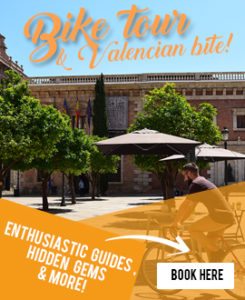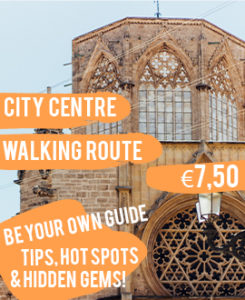Valencia has a lot of festive days, including San Vicente Ferrer. This day is celebrated each year on the second Monday after Easter. In 2019 this will be on Monday the 29th of April. But who was San Vicente Ferrer and what do the Valencians do on this festive day? We will tell you all about his history and more!
What do the Valencians do on this festive day?
Most of the Valencians see this public holiday as a day off to spend with family and friends. They often go to the park or walk along the beach. Some of them visit Casa Natal de San Vicente Ferrer. But the religious activities around this day already start the Sunday before the official festive day. Ferrers sculpture will be taken to several altars in the city and on Monday a lot of people visit the church and leave flowers at Casa Natal. In the afternoon a procession is organized around the Cathedral of Valencia. But actually, who was Vicente Ferrer and why did he become a saint?
Who was Vicente Ferrer?
Vicente Ferrer was born in Valencia on the 23rd of January in 1350. When growing up, he started studying Latin and when he was 17 years old he joined the Dominican order in Valencia. He studied here, but was also sent to Lleida, Toulouse and Barcelona by the higher members of the Dominican. Finally, he became professor of theology.
Travelling and preaching around the world
Vicente Ferrer travelled a lot during his life. He travelled to Spain, Northern Italy, Germany, Belgium, Southern France and Burgundy. In the meantime, he was attracting a lot of people by preaching. This was all caused by the vision he got after a bad period of illness. He was supposed to become a pope, but looked death in the eyes during his illness and got a vision. When this vision came up in 1396, he got better immediately and started travelling. During his travels the crowds gathered around him in temples. Until the temples were not big enough anymore and Ferrer needed to preach in fields. All the people who converted themselves to Vicente, received a special treatment from him. He invested in their education and training and arranged their pensions.
He loves me, he loves me not
A lot has been written about San Vicente Ferrer. Amongst others two different stories about his opinion on Jews. Some people argue that he tried to convert Jews to Christianity and when they didn’t want to be converted, they would be killed. They would have called him one of the biggest anti-semites in Spanish history.
Another story about Vicente stands in contrast to the earlier one. They say that Ferrers opinion about the Jews was positive and that he did none of the things mentioned above. Unfortunately, we still don’t have enough evidence to find out which one of the stories is right. So the two stories will be told, until the truth is revealed.
Compromise of Caspe
In 1412, Vicente Ferrer made himself of great value during the Compromise of Caspe. There was uncertainty about who would be the heir to the throne of the Kingdom of Aragon after King Martin of Aragon passed away. In order to find an heir to the throne, three representatives of Catalonia, Aragon and Valencia needed to vote. Vicente Ferrer wanted to be a representative of Valencia, so he travelled to Caspe, a place in the province Zaragoza. Here in Caspe, he voted for Fernando de Antequera. It turned out that most of the people voted for this man, so he became the new king of Aragon. This process in Caspe is now called ‘Compromise of Caspe’, in which Ferrer played a big role.
Storm in Vannes as a sign of God
Vicente Ferrer kept on travelling, preaching and inspiring people around him until the last days of his life. He had been in the United Kingdom and France when he was continuing his way back to Valencia. But then a storm came up in Vannes, France. Vicente thought of this storm as a sign of God to return to France and therefore, he stopped his journey and went to France. Here, in 1419 he died on the 5th of April.
From Vicente to San Vicente
The full name ‘San Vicente Ferrer’ did not exist yet during his life, but came up afterwards, on the 29th of June in 1455. On this date a voting took place in the Board of Cardinals after the monks had studied the life, the works and the decisions of Vicente Ferrer. The results of this voting led to the name ‘saint’. Nowadays, San Vicente Ferrer is one of the most important patron saints of the entire community of Valencia. This includes Castellón, Valencia and Alicante.
House of San Vicente Ferrer
In the city centre of Valencia you will find the house where San Vicente Ferrer grew up. At least, that is how it is called: ‘Casa Natal de San Vicente Ferrer’, which means birth house of San Vicente Ferrer. Actually, he did not grow up in this house exactly, but only in this place. The house serves more as a memory of the saint and his history.
At the entrance of the house you will find a ceramic panel designed in the 20th century with the street name ‘Calle del Pouet de San Vicent’, which is named after Vicente Ferrer. The facade is decorated with golden details and wooden carvings. Besides that, the house features a Gothic, octagonal church in which you will find a pine wooden sculpture of San Vicente.
Location
Carrer del Pouet de Sant Vicent 1
46003 Valencia
Opening hours
Monday to Friday: 10:00 – 13:00 and 16:30 – 20:30
Saturdays and Sundays: closed
Price
Free entrance
Tips
- A lot of supermarkets will be closed on the day of San Vicente Ferrer. If you need something, supermarket Carrefour will be open.
- Would you like to visit some sights around this festive day? Some of them have deviant opening hours that you need to take in account.





